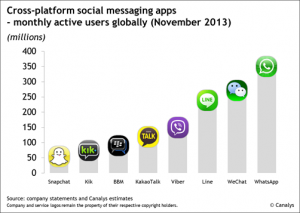the Social Sidekick: Messaging Apps teens are using
It has been well documented that teens have been “flocking away” from Facebook for some time now. I’ve even written about it on this blog before. Even though teens are moving away from Facebook, they are NOT moving away from social media and messaging sites.
What’s the reason behind teens using messaging apps instead of Facebook or Twitter? According to Business Insider, “Part of the reason is that gradual encroachment of the grey-haired ones on Facebook. Another is what messaging apps have to offer: private chatting with people you are friends with in real life. Instead of passively stalking people you barely know on Facebook, messaging apps promote dynamic real-time chatting with different groups of real-life friends, real life because to connect with them on these apps you will typically already have their mobile number.” (Reference).
Because of this trend, I thought it might be good to go through a list of some of the texting and social media apps that teens are using on a regular basis:
-

A list of some of the most popular social messaging apps. Kik. Kik is described on their website as “the first smartphone messenger with a built-in browser, Kik Messenger lets you talk to your friends and browse and share any web site with your friends on Kik.”
- Snap Chat. Because there is no “about” section on their website (which seems odd), Snapchat is described on the iTunes store as this – “Experience a totally new way to share today. Snap a photo or a video, add a caption, and send it to a friend (or maybe a few). They’ll view it, laugh, and then the snap disappears from the screen – unless they take a screenshot! If you want to share a Snap with all of your friends, add it to your Snapchat Story, where each Snap lives for 24 hours until it disappears, making room for the new.”
- WhatsApp. (which is now owned by Facebook). WhatsApp is “a cross-platform mobile messaging app which allows you to exchange messages without having to pay for SMS. WhatsApp Messenger is available for iPhone, BlackBerry, Android, Windows Phone and Nokia and yes, those phones can all message each other!”
- WeChat. WeChat is “a new and powerful mobile communication tool. It supports sending voice, video, photo and text messages. You can also do group chats, or you can find new friends nearby to talk to. WeChat works on iOS, Android, Windows Phone, Symbian and BlackBerry devices.”
- KakaoTalk. KakaoTalk “is a free mobile messenger application for smartphones with free text and free call features. It is available on iOS, Android, Bada OS, BlackBerry, Windows Phone, and Personal Computer.”
As you can see, the apps are pretty similar with little differences between them. The biggest similarity, other than their popularity (see chart above) is that they are all free and offer more privacy than social media or regular text messaging. With SnapChat, the message actually deletes (although nothing is ever deleted in the technology world).
So where does that leave us? As parents, it helps us keep an eye on our children and be aware of how they are communicating to their friends. It’s ok to be nosey because we should know what our teens are up to. As youth workers, it also helps us connect with them in other ways than just Twitter, Instagram and Facebook.
What do you think? Have you had experiences with these? Are there different ones out there you know tweens and teens are using?
